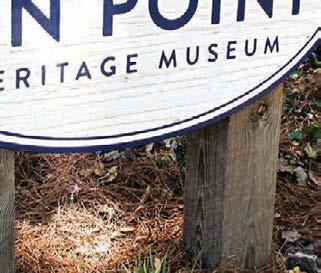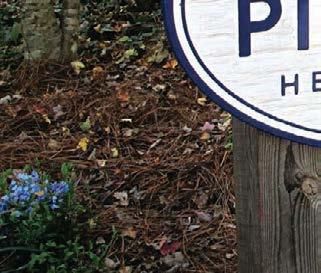
5 minute read
THE BIG PICTURE
Completion of the Santa Fe Trail to Fair Park is expected to start in the fall and spring of 2013. Meanwhile the approved Dallas Bike Plan includes a Santa Fe-Katy trail connection via Downtown. In all, the city plans to increase the total number of city trail miles from 111 to 284. Dallas has, and will have, a lot of great trails, city leaders say. Once that happens, how can the city make the trails easier to use and encourage people to use them? A team of designers, engineers, city leaders and other creative minds tackled this question through the GOOD Ideas for Cities effort. No studies have been conducted on how trafficked the trails are already, according to Michael Hellman, manager of Park Planning and Acquisition for the City of Dallas, but this team is looking to get people out of cars and onto trails. After two months of thinking and spending time on the trails, the Connect the Dots/Bike Hike Trailsteam offered solutions. Their main idea includes creating an umbrella brand to market the trails, which would connect the Katy, White Rock, Santa Fe and other individual trails with an overarching identity. Other ideas are to put up signs to clearly mark intersections, and design an app that would allow users to map journeys via trails and alternate transportation.The app, which still needs a developer, would also help you track your progress and find nearby amenities such as bike repair shops. The team is hoping to gain approval from the Dallas Park Board soon so they can put their ideas into action. Samuel Stiles, director of development for the Dallas Parks Foundation, says he hopes the umbrella brand will not overshadow the existing trails but instead simplify messaging and ease marketing. For example, you might see more ads for the example brand GO: Get Outside Dallas, rather than individual ads for each trail. Though he has not heard from representatives of all the existing trails, Stiles says several have given him positive feedback.
— Lauri Valerio
‘For the grands to come’
Neighborhood startup designs Gullah/Geechee heritage museum

Story by Rachel Stone
The last black-owned property on the southeastern coast of the United States, Pin Point, Ga., is actually three tiny islands. Pin Point native Herman Haines explains this in the opening scenes of “Take Me to the Water, The Story of Pin Point.”



The 30-minute film was co-executive produced by neighborhood resident Travis Hopper and his business partner, Brian Owens.
Hopper and Owens, who had worked together for years at the Richards Group, started up their own firm, O&H Brand Design, last year. Two months later, they were hired to help create the Pin Point Heritage Museum, whose aim is to preserve the town’s heritage, and thereby, that of the Gullah/Geechee people of the coastal southeastern United States.


Gullah/Geechee is a culture that can be compared to the Creoles of Louisiana. The Gullah and Geechee are descendants of African slaves. The white masters of those slaves lived elsewhere because of mosquito-borne illnesses. Their indigo-growing plantations and fisheries, amid the marshy islands from North Carolina to southern Georgia, were run entirely by Africans.
That resulted in an isolated culture that combined traditions from West Africa with New World ones. The Gullah/Geechee have a language, musical tradition and culture all their own. “Michael Row Your Boat Ashore” is one song that comes from the coastal culture.
Freedmen bought the three islands that comprise Pin Point more than 100 years ago. Every other piece of coast that once belonged to Gullah/Geechee, such as Hilton Head, N.C., has been gobbled up by developers.
Harlan Crow, the Dallas real estate magnate, financed the Pin Point Heritage Museum. It is housed in the former A.S. Varn & Son oyster and crab company, a long white building with a red roof on the banks of the Moon River. The building is iconic in the area, south of Savannah, Ga., having served as the main source of income for Pin Point until it closed 1985.
Part of O&H Brand Design’s charge was to find stories and artifacts for the museum and then use those to design the museum’s spaces.
Linguists and other academicians have studied Gullah/Geechee culture for years. But not much was available in the way of true stories from everyday life, Hopper says.
“People who had lived through the golden age of [Pin Point] were getting old and dying,” Hopper says.
So he and Owens spent months traveling between Dallas and Savannah, visiting with and interviewing the residents of Pin Point.
Initially, they encountered some distrust. Supreme Court Justice Clarence Thomas is from Pin Point, and in 1990, when he was accused of sexual harassment, the media portrayed Pin Point as backward, Hopper says.
“We had to gain the trust of the community,” Hopper says.
Telling the story 18 months later at his renovated mid-century modern home in Lochwood, Hopper notes that he has the cell numbers of most Pin Point residents programmed into his phone now. Even though the project is over, and the museum opened last month, they still keep in touch.
Hopper and his wife, Desiree, named their first baby Savannah Pearl, when she was born in May of last year. Baby Savannah was like a mascot at a Pin Point screening of

We specialize in the complete care of chronic pain with the most advanced techniques, treatments and equipment.
Some of the many conditions treated:

Back, Hip and Knee Pain
Degenerative Disc Disease/Discogenic Pain
Sciatica/Radicular Pain
Failed Back Surgery Syndrome
Neck, Shoulder and Arm Pain
Headache Pain, Facial Pain, TMJ
Abdominal Pain
Pelvic Pain
Cancer Pain
Arthritis Pain
“Take Me to the Water” in August, Hopper says.
The firm designed the interior of the museum to look as close to the original canning factory as possible.
“We wanted it to feel familiar to the people who came in and saw it,” Hopper says.
Throughout the museum, they use a typeface that was inspired by the typography of the oyster cans. The museum’s logo is the profile of a man rowing a small boat. And the colors, washed out blues and greens, were inspired by the water and marshes.
There are community artifacts, a recreation of the crab-picking room and other parts of the factory in the museum.
There are enlarged black-and-white photos of community members and their unique Pin Point nicknames — Nerve, Peaches, Pig, Manny, Dooky Dooky — along with audio outtakes from the film.
Hopper and Owens produced the film because they realized early on they could never tell the story of Pin Point as well as its residents and natives themselves.
Director Je Bednarz shot 250 hours of film over 15 days, and it was edited into a fascinating, funny, tear-jerking, feel-good 30 minutes.
“It was fortunate for us to start this proj- ect when (our company was) just starting up,” Hopper says. “We were able to get fully immersed in it.”

Since O&H Brand and Design started, the firm has tripled in size. That is, from two to six employees. Their clients now include Raising Cane’s, Atmos Energy and the Center for Brain Health at UT Dallas.
Their work in Pin Point is done, but they left part of themselves there.
Hopper says Pin Point residents were pleased with the film.
“Having them say we got it right,” Hopper says, “that was the validation we needed.”
As John Henry Haines Jr., aka Pig, says at the end of “Take Me to the Water,” he prays that the heritage and the town of Pin Point itself will be preserved, “for the grands to come.”









